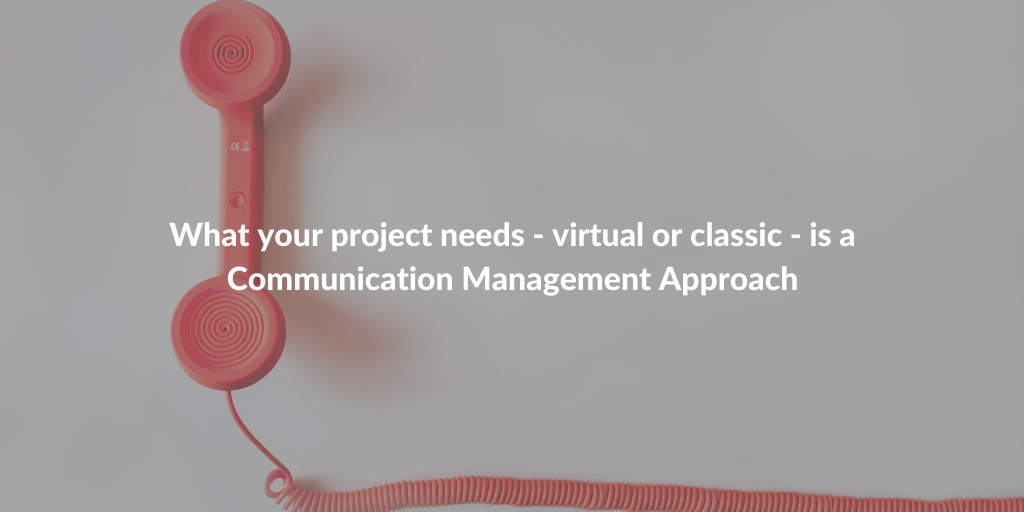Communication in virtual Projects

In a virtual project, your team works from different locations.
We have seen project teams becoming more virtual for many years – flexible work conditions, external vendors or partners, outsourced teams – and communication is the most important hurdle that keeps popping up. Effectively communicating within your project team is more cumbersome when your project team is not co-located.
A lot of the difficulties lie in the soft aspects of communication: you often lack the visual cues on how a spoken message is received. In written communication, the sender has the tendency to be more negative in communicating the message and the receiver has the tendency to interpret the message more negatively than intended.
The hardest part in remote communication is to create that feedback loop that ensures a message is received as it was intended. When it comes to the mechanics of communication, however, your approach in a virtual environment should actually be quite similar to a situation where everybody is working from the same place.
The problem is that many inefficiencies do not surface as much when you are working in the same building, as you often run into each other or can quickly swing by someone’s desk.
But as usual: time spent in preparation is time gained in execution.
What your project needs – virtual or classic – is a Communication Management Approach.
PRINCE2 the Communication Management Approach
As in many project management challenges, PRINCE2 gives guidance on how to tackle communication challenges. PRINCE2 is the de facto standard project management method in many parts of the world.
And on the topic of communication, it provides guidance in the form of the Communication Management Approach, as well as on how to use it throughout the project life-cycle.
PRINCE2 is often considered document-heavy or bureaucratic, but that is a misinterpretation.
I rather use PRINCE2 as a checklist of things I need to clarify and agree upon with my project stakeholders.
My favourite quote from the PRINCE2 manual (p. 27) states that “it is important to remember that effective project management requires information (not necessarily documents) and decisions (not necessarily meetings).”
The situation will determine how well documented this information should be, and whether decisions should be taken in a meeting or not. So let’s have a look at the Communication Management Approach PRINCE2 proposes and how it helps in managing virtual projects.
Strictly speaking, the Communication Management Approach deals with the means and frequency of communication with parties both internal and external to the project. I will not go into detail on the external stakeholder identification, analysis, and engagement, but rather focus on internal communication, i.e. with the project team.
Tools & Techniques
PRINCE2 is agnostic of tools, so there are no recommendations in the guidance.
My advice typically boils down to “do not overthink it”. After all, a fool with a tool is still a fool. So look at the tools that your organisation already uses first. Don’t rely too heavily on email; email is a bad medium in general, but a bad habit is hard to kill.
The email has a tendency to lead to communication overload. It is far more useful to use chat tools for written communication, it’s more informal so lowers the effort people spend on the format. That leaves more time for content. Next to a chat, it is also good to have a tool for online meetings, typically videoconferencing, that everyone can easily access from different devices.
A screen sharing option is mostly included and very useful. It’s important to have good agreements on how the tools will be used. As a project manager, you should make the guidelines explicit and lead by example.
Things to consider are the use of webcams or the mute button for the videoconferences, or the topic structure and use of mentions in the chat. Also, make sure that it is clear which tool will serve what purpose – this is especially important when there are several tools at hand that can do more or less the same.
Records
You should keep track of communication records: decisions taken, actions agreed, topics that need to be discussed… Again, email is a bad medium. But you do not necessarily need fancy tools: a lot can be done with a simple document on a shared location that everybody can access.
Make sure that everybody knows where they can find what information. Also here it is probably easier and safer to use the technology that your organisation already provides, rather than shopping for new solutions.
Timing
Agree when you or others should communicate.
That includes the meetings you will have. Online meetings tend to be much more exhausting than offline discussions, and people working from home sometimes have other distractions, like children.
So, in a virtual setting even more so than in a classic situation, it is important to keep the number of meetings to the strict minimum! Clear roles and responsibilities and well-defined deliverables will help to reduce the number of synchronous sessions with several people online.
Roles & Responsibilities
Make sure to clarify who is responsible for what communication.
This means organizing meetings or administering chat groups, but also who should respond to what type of questions. The more you clarify these things upfront, the smoother your project will run.
Informal communication
Finally, the above is mainly dealing with formal communications.
When I am coaching project managers, I tend to advise them to choose a desk close to the coffee machine. However, it won’t make sense, when working from home, to sit close to your own coffee machine.
In an organisation, the coffee machine has the informal function of eliciting real conversations: here you get the real status, the real issues and risks and the real learnings from project team members. So, do not forget these informal moments – try to include them in your routine.
That means inviting people for a one-to-one video chat just to have a chat, or organizing a virtual apéro where everyone shares a drink.
The drawback of virtual projects is that you need to force some formalization in informal encounters.
Stijn Janssens
 Written by: Stijn Janssens is a trainer and consultant.
Written by: Stijn Janssens is a trainer and consultant.
He is PMP, PRINCE2, MSP, MoP, P3O and ITIL certified.
He has a lot of experience in strategic innovation and the ‘change’ part of organizations.
He is not religious about PRINCE2, but very convinced!








